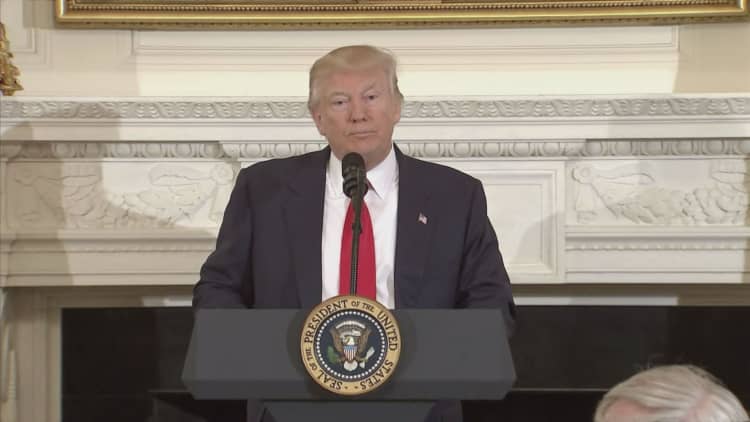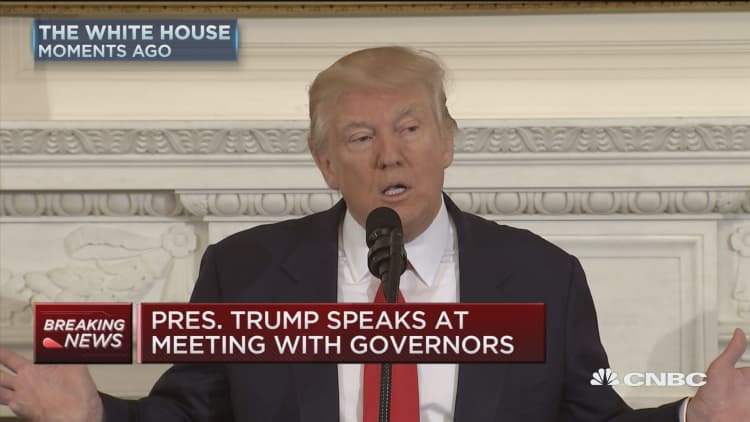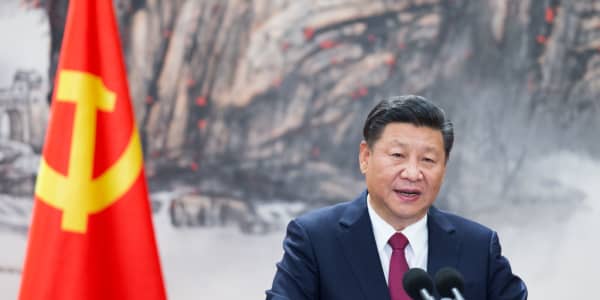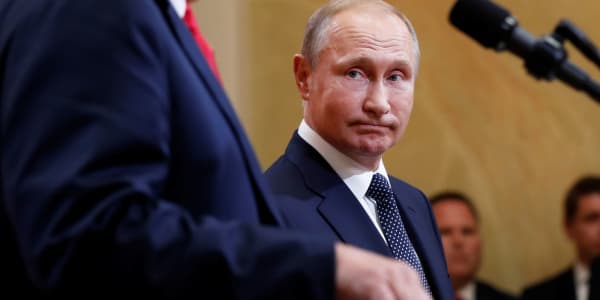
On Tuesday, during a joint session of Congress, it's expected that President Trump will announce his plan to spend $54 billion to strengthen the U.S. military, after five years of budget cuts and a shrunken U.S. Defense Department Budget. During his campaign, he pledged to expand the naval fleet, add more Air Force fighter aircraft and modernize missile defense and cybersecurity.
World leaders will be acutely tuned in to the leader of the world's most powerful (and most costly) fighting force, who on Friday vowed to kick off one "greatest military buildups in American history" at the Conservative Political Action Conference. According to reports the White House plan calls for a total of $603 in military spending.
The U.S. defense industry will especially be tuned in. The $100 billion global weapons trade is booming, and the United States remains the industry's firmly entrenched leader, accounting for 33 percent of the world's arms exports.
Last year U.S. arms exports reached roughly $38 billion, according to management consulting firm Avascent. America's biggest customers: Saudi Arabia (13 percent), the United Arab Emirates (8.7 percent) and Turkey (6.3 percent).
Alongside sales of combat aircraft, like Boeing's F-15, the United States enjoyed particularly strong demand for its missile defense systems, such as the Patriot PAC-3 system, produced by Raytheon and Lockheed Martin. Saudi Arabia, Japan, Kuwait, Qatar, Poland, Taiwan and the UAE have all selected, ordered or received PAC-3 systems since 2012 as a counterweight to perceived regional missile threats, including those from Iran and North Korea.
More from Global Investing Hot Spots:
This is the biggest loser if Trump ignites a trade war with China
Investors beware: 5 risks that can unravel the EU IN 2017
Red alert: North Korea one step closer to the missile test that can rock the US
But even as demand for sophisticated military equipment — everything from guided aerial bombs to fighter jets to missile defense systems — spikes across the globe, analysts note that the competitive landscape is growing more nuanced as well. A rising tide of defense spending may not lift all defense contractors as evenly as in previous eras of military largesse as new political realities bump up against an industry where any individual deal can be part commercial transaction, part diplomatic maneuver and part foreign trade negotiation.
According to data released this month by the Stockholm International Peace Research Institute (SIPRI), between 2012 and 2016 international arms deals increased by 8.4 percent over the previous five-year period, the highest increase for any five-year period since the end of the Cold War. Compared with the five years preceding, the United States increased its arms exports by 21 percent during that period, a reflection of the growing importance of foreign military sales to large U.S. defense contractors as domestic budget pressures have curtailed U.S. defense spending at home.
The heated arms race
Even as Trump lays out ambitious plans to grow the U.S. defense budget, U.S. defense contractors face increased competition from foreign competitors as governments around the world question U.S. commitment to longstanding defense relationships.
Arms exports to foreign militaries have made up an increasing share of U.S. defense contractors' revenues over the past several years. Driven largely by ongoing conflicts around the globe and defense budget caps in the United States (the spending limits widely referred to as sequestration), major American defense contractors like Lockheed Martin, Boeing, Raytheon and Northrop Grumman have maintained their bottom lines by finding new customers abroad, largely in Asia and the Middle East.
Avascent estimates that in both 2015 and 2016, foreign military sales made up 20 percent of U.S. defense firms total sales, and a survey conducted by the company last year found that 91 percent of industry executives believe the importance of exports to the U.S. arms industry will continue to grow in the years ahead.
Those numbers square with SIPRI's analysis of global arms transfers, which unsurprisingly show a spike in demand for military hardware from Middle Eastern nations (which accounted for 29 percent of arms imports between 2012 and 2016) and Asia/Oceania (43 percent of imports). In the Middle East, ongoing conflicts in places like Syria, Yemen and Libya have depleted regional stockpiles of expendable military hardware, like aerial bombs and missiles, and driven up demand for the sophisticated systems, like the fighter jets and ground vehicles that deliver those weapons to the battlefield. In Eastern Asia a rapidly modernizing Chinese military is likewise driving what some are calling a regional arms race.
Europe's second wave
Meanwhile, Russian military actions in Ukraine and pressure from the Trump administration have breathed new life into a European defense market to which U.S. defense firms have paid relatively little attention in recent years. Both U.S. Secretary of Defense James Mattis and Vice President Mike Pence made separate tours of Europe over the past month, each urging leaders of NATO member states to boost defense spending to meet a target of 2 percent of GDP in each nation.
If every state were to meet that 2 percent target, overall European defense spending would increase by $100 billion annually, Cowen and Co. defense analyst Roman Schweizer says. Roughly $20 billion of that would likely go to new equipment purchases each year.
But spiking demand for military hardware — even among the United States' NATO allies — does not automatically translate into sales for U.S. defense contractors. With the election of Trump signaling a potential reset of U.S. military relationships around the globe, European governments could choose to rely more heavily on European defense contractors like BAE Systems in the U.K. or Airbus and Thales in France to fulfill their military hardware needs for combat jets, helicopters, ground vehicles and other military hardware.
Meanwhile, countries like India, Brazil, Israel, South Korea and especially China have taken action in recent years to reduce their reliance on arms imports by developing their own indigenous arms industries. Israel produces sophisticated missile defense systems and aerial drones. Brazil's Embraer sells light-attack aircraft, South Korea produces its own battle tanks, and China is capable of building and selling everything — from cruise missiles and naval vessels to armed aerial drones.
China in particular has emerged as a potential competitor to U.S. companies looking to sell military hardware abroad, including sophisticated, lethal systems, like armed aerial drones. Although SIPRI's data indicate that Chinese military exports only accounted for 6.2 percent of global arms traffic from 2012 through 2016, that represents a 74 percent increase for China compared with the previous five-year period. It is now the world's third-largest arms exporter, though it still significantly lags the United States (33 percent) and Russia (23 percent).
Changes on the demand side will also complicate future weapons deals. For instance, India — the world's largest weapons importer — has embarked on a major reform of its defense spending procedures, prioritizing purchases from indigenous companies. These reforms include a push for so-called "offset" arrangements, wherein companies that sell military hardware to India are required to reinvest part of the value of a contract into Indian research and development, usually by awarding contracts for components to Indian manufacturers or moving some of their manufacturing to India — policies that could collide head-on with Trump's "America first" posture.

"There's an inherent tension that [U.S. defense contractors] are going to face, because every time you sell internationally, there's perception that you're creating jobs in an international market," Avascent managing director Jon Barney says. "And at the same time you're going to need to be able to show that you're making jobs in the U.S. through an international sale."
A new marketing approach
These new competitive pressures — along with uncertainties surrounding American military commitments under the Trump administration — will change the way U.S. defense contractors shop their wares to the world. "I think, for U.S. firms, they're going to have to navigate this a little differently," Barney says.
Among European NATO allies, for instance, European defense contractors competing with U.S. companies could make the case that with American future military support uncertain, it makes more sense to source critical military systems from within the European Union. How U.S. defense contractors counter such claims and reach out to European militaries — a market to which they've given relatively little attention since the end of the Cold War — will determine which companies benefit from the coming uptick in European defense spending.
Such an environment could make it difficult for smaller American companies in the defense space to make inroads with foreign militaries, while major U.S. defense primes, like Lockheed Martin, Boeing, Raytheon, Northrop Grumman and General Dynamics, which already do business overseas, will continue to benefit from those relationships, Schweizer says.
New challenges notwithstanding, global spending is moving in the right direction for defense contractors, he says. In Europe in particular, governments are experiencing pressure to boost spending that hasn't existed in a quarter century. "Momentum is clearly to the upside," Schweizer added. "I think European defense spending has bottomed."
Meanwhile, while Trump's unique brand of diplomacy may complicate arms sales in the near term, most governments that are ratcheting up defense spending are doing so in response to challenges and priorities that will outlive any U.S. presidency.
"A lot of these countries that have been big consumers — Saudi Arabia, Japan, UAE — the underlying threats and economic drivers for them to procure defense products are all still there," Barney says. Barring something unforeseen, that demand isn't going anywhere anytime soon.
"There's been a reshaping of the international order," Schweizer says. "These are multi-decade challenges that these countries are going to prepare for."
— By Clay Dillow, special to CNBC.com





